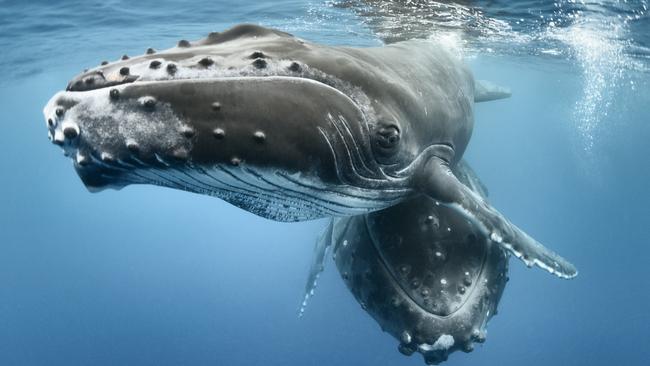Ship speed limits flagged around busy Australian ports to protect whales from deadly collisions
The recovery of some whale species amid massive increases in shipping is creating a new threat for the leviathans – and one that could mean changes to Australian shipping.

Ship speed limits would be imposed around some of Australia’s busiest ports to tackle a growing problem of vessels striking whales, under a plan being put to authorities next week.
Whales and global shipping are on a collision course, literally, as species such as humpbacks recover from whaling amid a trebling of ship numbers – often in the same ocean corridors.
Ship collisions, also known as strikes, are now one of the leading causes of human-induced whale deaths and are for some populations responsible for more than half of all mortalities.
Permanent or seasonal ship speed restrictions have been introduced in whale “hot spots” by the US, Canada, New Zealand and Argentina, typically imposing 10 knot limits, while some shipping lanes have been re-routed.
A report to be released next week by the World Wide Fund for Nature will urge Australia to follow suit, singling out east coast shipping lanes overlapping with humpback and southern right whale habitat and migratory routes.
“While humpback whales off both coasts of Australia are showing strong recovery after whaling, conservative estimates predict a doubling of shipping traffic in the region by 2025,” said Chris Johnson, global lead with WWF’s Protecting Whales & Dolphins Initiative. “This poses a mounting threat to these whales in their breeding grounds.
“WWF believes there is an argument for a speed limit during the whale season in the entire Reef World Heritage Area, which has four major ports: Gladstone, Hay Point, Abbot Point and Townsville. And speed limits should be explored outside major ports along the east coast, from at least Eden (NSW) north. Historically, the east coast of Australia has heavier shipping activity and more reported fatal collisions, but protection for the west coast should also be examined.”
The federal government recognised the issue in 2017, developing a National Strategy for Reducing Vessel Strike on Cetaceans, but Mr Johnson said it was time to follow up with “concrete mitigation measures”.
With political parties looking to establish environmental credentials at the looming federal election, next week’s Blueprint for Australian Oceans Leadership report argues this should include “whale safe” ship routes. Whale strikes can cause horrific injuries from the impact of steel hulls and propellers, leaving whales to die slow, painful deaths.
Research shows that short of separating ships and cetaceans, the answer is slowing vessels in key hotspots, with a reduction from 15 knots to 8.6 knots cutting fatalities from 79 per cent to 21 per cent.
A study into speed limits imposed to protect North Atlantic right whales found they reduced fatality risks by 80 to 90 per cent.
“Seasonal, mandatory speed limits in key areas where there is high traffic – specifically in and out of major ports – will help us reduce risks of ship strikes,” Mr Johnson said.
“The process to introduce ship speed limits to protect whales should be led by the federal Australian Marine Safety Authority in consultation with the states.”
There was particular concern about Moreton Bay, Queensland. “Container trading is estimated to increase 300 per cent by 2045, and a newly built Brisbane cruise ship terminal is transforming Moreton Bay into a mega-cruise ship destination,” Mr Johnson said.
“At the same time, Moreton Bay has recently been identified as a potentially important (humpback whale) mother-calf resting and nursing area … Resting behaviour occurs at or just below the surface. The weaker blows of calves and resting individuals also make them less visible to approaching vessels. Combined, these factors make mother-calf pods particularly vulnerable to ship strike.”
WWF’s Ocean Blueprint calls for “blue corridors” in whale and dolphin critical habitats and migration routes, including shipping speed limits where needed and measures to prevent bycatch. It says while the Albanese government set a “bold agenda for ocean protection” on coming to office in 2022, most concrete steps “remain in the planning stage”.
Environment Minister Tanya Plibersek declined to comment but her department said the threat of whale-ship collisions was “taken into consideration during the development of conservation strategies, such as recovery plans, for threatened species in Australian waters”.
AMSA said it “provides guidance for mariners on preventing collisions with whales”.








To join the conversation, please log in. Don't have an account? Register
Join the conversation, you are commenting as Logout